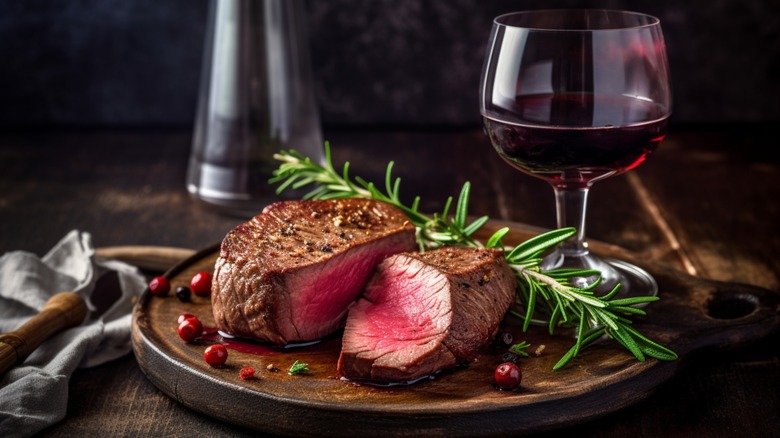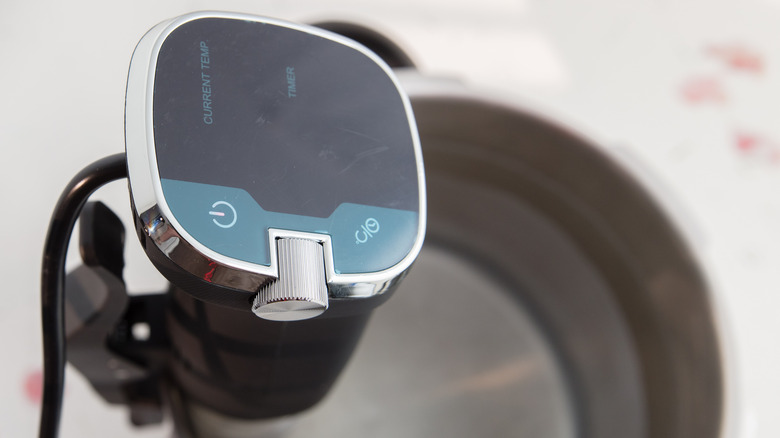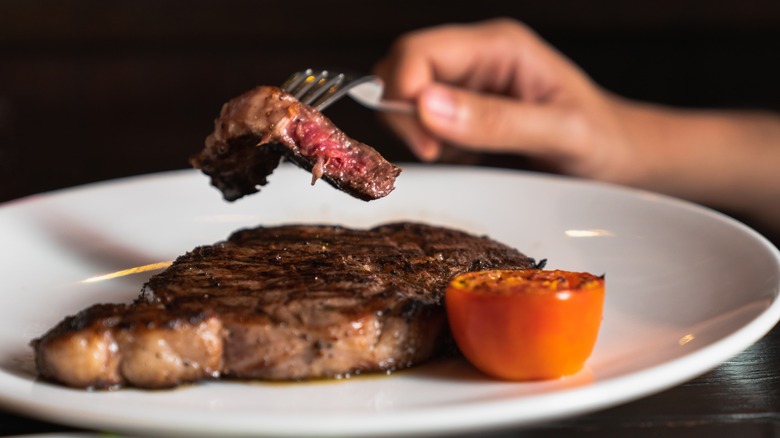Why You Should Use Sous Vide To Cook Thick Steaks
We may receive a commission on purchases made from links.
A thick, juicy steak can solve nearly all your problems (if your problem is that you're hungry), but some cuts of steak are more difficult than others; especially if you're an inexperienced home cook or the steak is, in fact, super thick. You can leave it on the skillet for such a long time that the outside 'crust' is more like what remains after a raging campfire, or you can turn to the French cooking technique, sous vide, where vacuum-sealed food is placed in water which is heated to a precise temperature and held there for an extended period of time.
"I typically sous vide at 110 degrees Fahrenheit for about 30 minutes, depending on the size of the steak," said Matthew Kreider, executive chef at Steak 954 in Fort Lauderdale, Florida. "This will never cook it past rare, and you can add herbs and salt while it's cooking."
This technique, which uses a relatively low temperature, helps melt the fat and lets it render into the steak, imbuing it with decadent meaty flavor while keeping it juicy and succulent. It also gently cooks the interior of even the thickest steaks to uniform perfection so that, once it's done to your liking in the water bath, you can sear that thick slab of meat on a screaming hot pan, build a beautiful crust, and not worry that the inside is totally raw (unless that's your preference).
Tips to make sous vide steak
There are a few things you can do to smooth along the sous vide process. For example, salting your steak before vacuum sealing it and putting it in the water bath creates a slightly chewy texture. So, if you like your steak to texturally resemble, well, steak, leave off salting it until the sous vide process is done; just before it hits the pan for a sear.
Also, if you were thinking of skipping buying the vacuum sealer by using a straw to suck out the air in your steak bag, we'd highly advise against that. As far as kitchen appliances go, they can be quite affordable, and there's no doubt you will find another use for it beyond making sous vide steaks. For starters, sous vide is a great way to heat up leftovers.
Finally, when it comes to sear your sous vide steak, if you've done multiples, you'll need a pan that measures at least a foot across so that you don't crowd the cooking surface (which makes it difficult to get a decent crust). You should always pat your steak dry, too, after it comes out of the water bath.
Sous vide steaks are for the people
If you thought sous vide was a technique strictly for high-end kitchens, you'd be wrong. Kreider encourages every home cook to try out the process and see what happens. "I think in this day and age, give it a shot!" Kreider said. "Vacuum sealers and sous vide machines are extremely accessible, and much cheaper than they used to be."
Kreider continued, "There is a ton of helpful information online to guide you through the process. My little brother is not a chef by any means, but he cooks everything sous vide. It's a time saver and gets more fun as you learn the process."
Once you get the hang of it, you might be surprised at how easy and convenient it is to sous vide your steaks before finishing them off on a hot skillet. You'll just set your sous vide device to your desired temperature (we recommend medium rare, or 129 degrees Fahrenheit, but do you), and then you can literally walk away from it for a few hours while it does its thing.


